ECO101 Assignment: New Keynesian Economics and Production Analysis
VerifiedAdded on 2023/01/11
|5
|617
|83
Homework Assignment
AI Summary
This economics assignment delves into the core principles of New Keynesian Economics, examining how it addresses the shortcomings of classic Keynesian theory. The assignment explores concepts such as coordination failures, menu costs, efficiency wages, and staggered prices, highlighting their si...
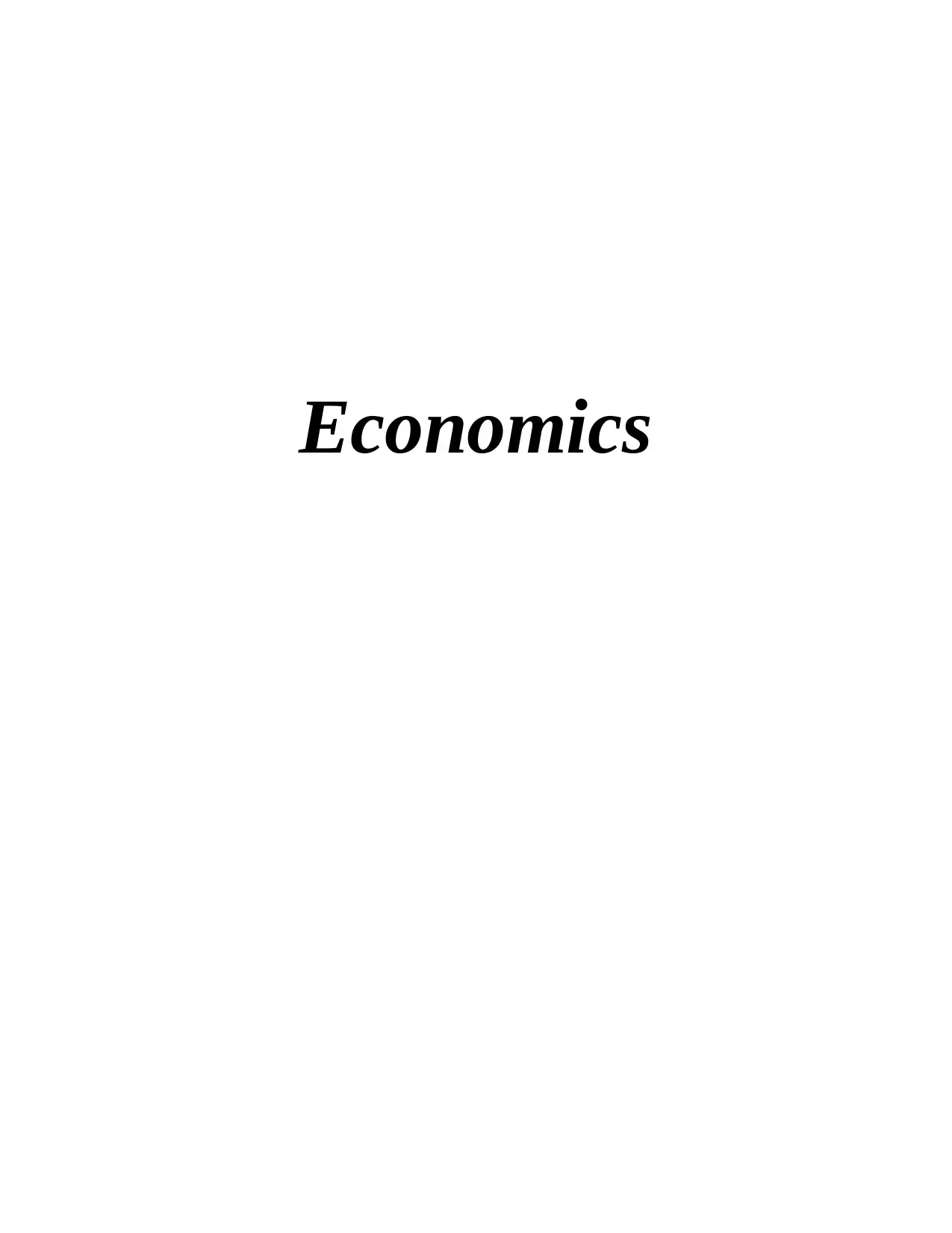
Economics
Paraphrase This Document
Need a fresh take? Get an instant paraphrase of this document with our AI Paraphraser
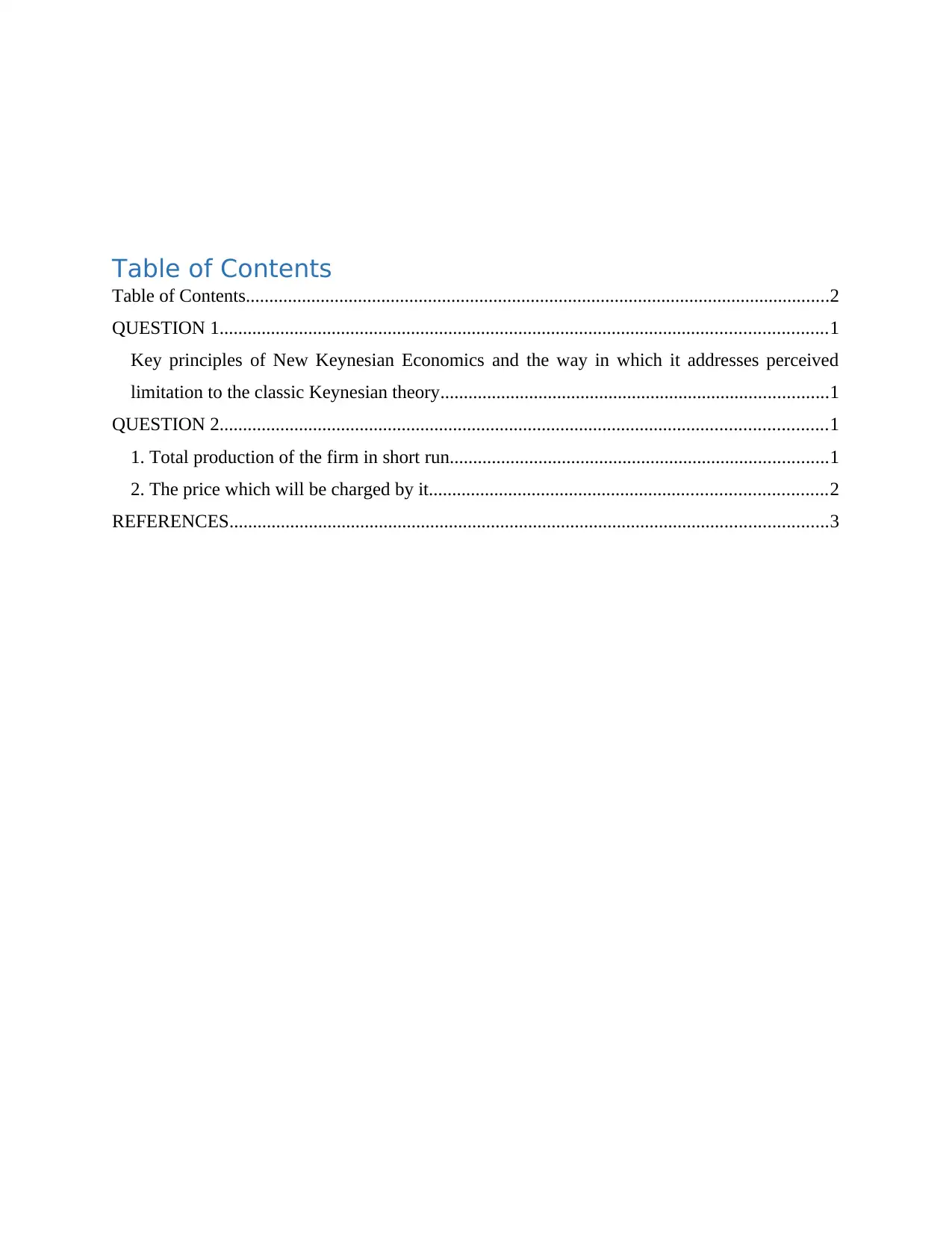
Table of Contents
Table of Contents.............................................................................................................................2
QUESTION 1..................................................................................................................................1
Key principles of New Keynesian Economics and the way in which it addresses perceived
limitation to the classic Keynesian theory...................................................................................1
QUESTION 2..................................................................................................................................1
1. Total production of the firm in short run.................................................................................1
2. The price which will be charged by it.....................................................................................2
REFERENCES................................................................................................................................3
Table of Contents.............................................................................................................................2
QUESTION 1..................................................................................................................................1
Key principles of New Keynesian Economics and the way in which it addresses perceived
limitation to the classic Keynesian theory...................................................................................1
QUESTION 2..................................................................................................................................1
1. Total production of the firm in short run.................................................................................1
2. The price which will be charged by it.....................................................................................2
REFERENCES................................................................................................................................3
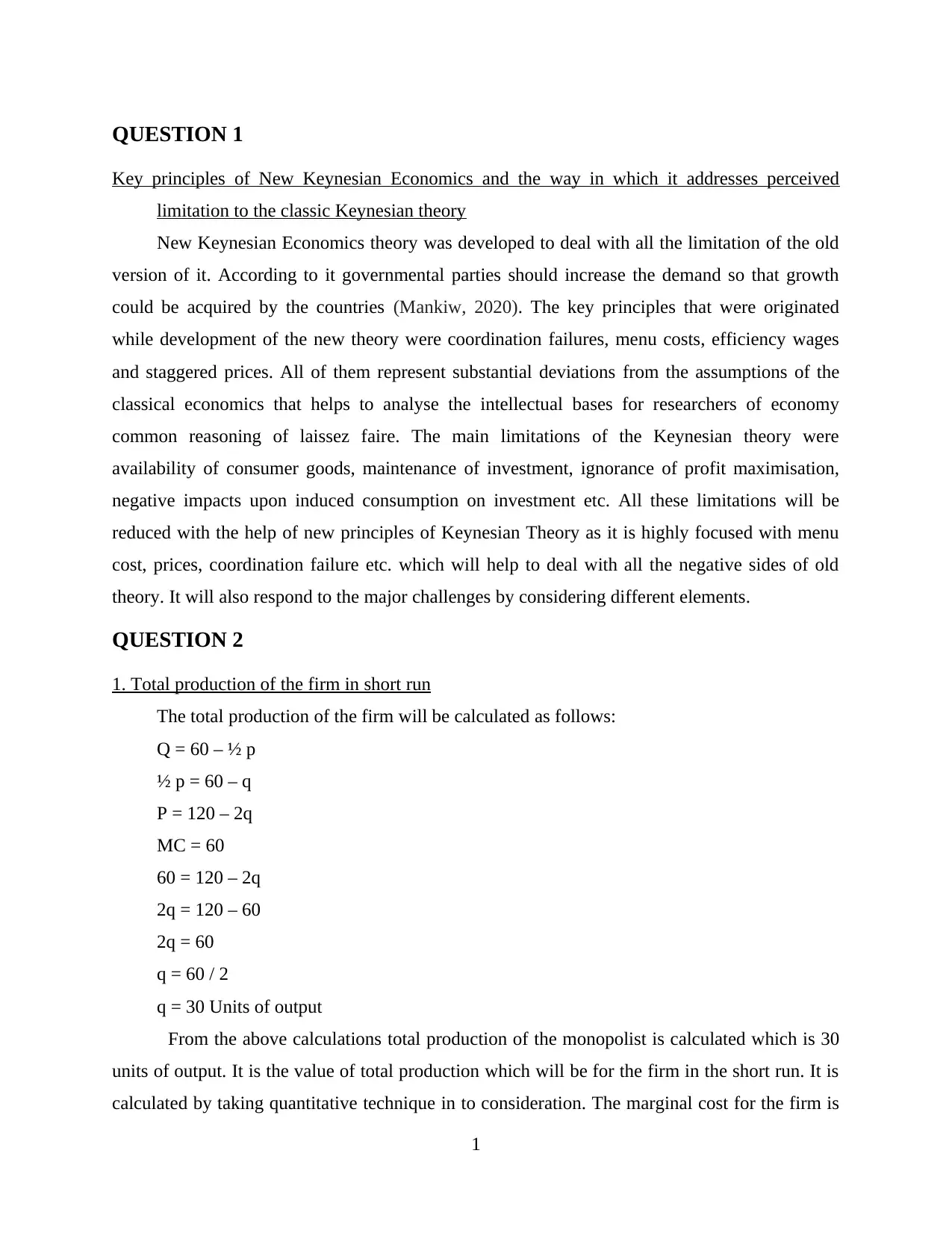
QUESTION 1
Key principles of New Keynesian Economics and the way in which it addresses perceived
limitation to the classic Keynesian theory
New Keynesian Economics theory was developed to deal with all the limitation of the old
version of it. According to it governmental parties should increase the demand so that growth
could be acquired by the countries (Mankiw, 2020). The key principles that were originated
while development of the new theory were coordination failures, menu costs, efficiency wages
and staggered prices. All of them represent substantial deviations from the assumptions of the
classical economics that helps to analyse the intellectual bases for researchers of economy
common reasoning of laissez faire. The main limitations of the Keynesian theory were
availability of consumer goods, maintenance of investment, ignorance of profit maximisation,
negative impacts upon induced consumption on investment etc. All these limitations will be
reduced with the help of new principles of Keynesian Theory as it is highly focused with menu
cost, prices, coordination failure etc. which will help to deal with all the negative sides of old
theory. It will also respond to the major challenges by considering different elements.
QUESTION 2
1. Total production of the firm in short run
The total production of the firm will be calculated as follows:
Q = 60 – ½ p
½ p = 60 – q
P = 120 – 2q
MC = 60
60 = 120 – 2q
2q = 120 – 60
2q = 60
q = 60 / 2
q = 30 Units of output
From the above calculations total production of the monopolist is calculated which is 30
units of output. It is the value of total production which will be for the firm in the short run. It is
calculated by taking quantitative technique in to consideration. The marginal cost for the firm is
1
Key principles of New Keynesian Economics and the way in which it addresses perceived
limitation to the classic Keynesian theory
New Keynesian Economics theory was developed to deal with all the limitation of the old
version of it. According to it governmental parties should increase the demand so that growth
could be acquired by the countries (Mankiw, 2020). The key principles that were originated
while development of the new theory were coordination failures, menu costs, efficiency wages
and staggered prices. All of them represent substantial deviations from the assumptions of the
classical economics that helps to analyse the intellectual bases for researchers of economy
common reasoning of laissez faire. The main limitations of the Keynesian theory were
availability of consumer goods, maintenance of investment, ignorance of profit maximisation,
negative impacts upon induced consumption on investment etc. All these limitations will be
reduced with the help of new principles of Keynesian Theory as it is highly focused with menu
cost, prices, coordination failure etc. which will help to deal with all the negative sides of old
theory. It will also respond to the major challenges by considering different elements.
QUESTION 2
1. Total production of the firm in short run
The total production of the firm will be calculated as follows:
Q = 60 – ½ p
½ p = 60 – q
P = 120 – 2q
MC = 60
60 = 120 – 2q
2q = 120 – 60
2q = 60
q = 60 / 2
q = 30 Units of output
From the above calculations total production of the monopolist is calculated which is 30
units of output. It is the value of total production which will be for the firm in the short run. It is
calculated by taking quantitative technique in to consideration. The marginal cost for the firm is
1
⊘ This is a preview!⊘
Do you want full access?
Subscribe today to unlock all pages.

Trusted by 1+ million students worldwide
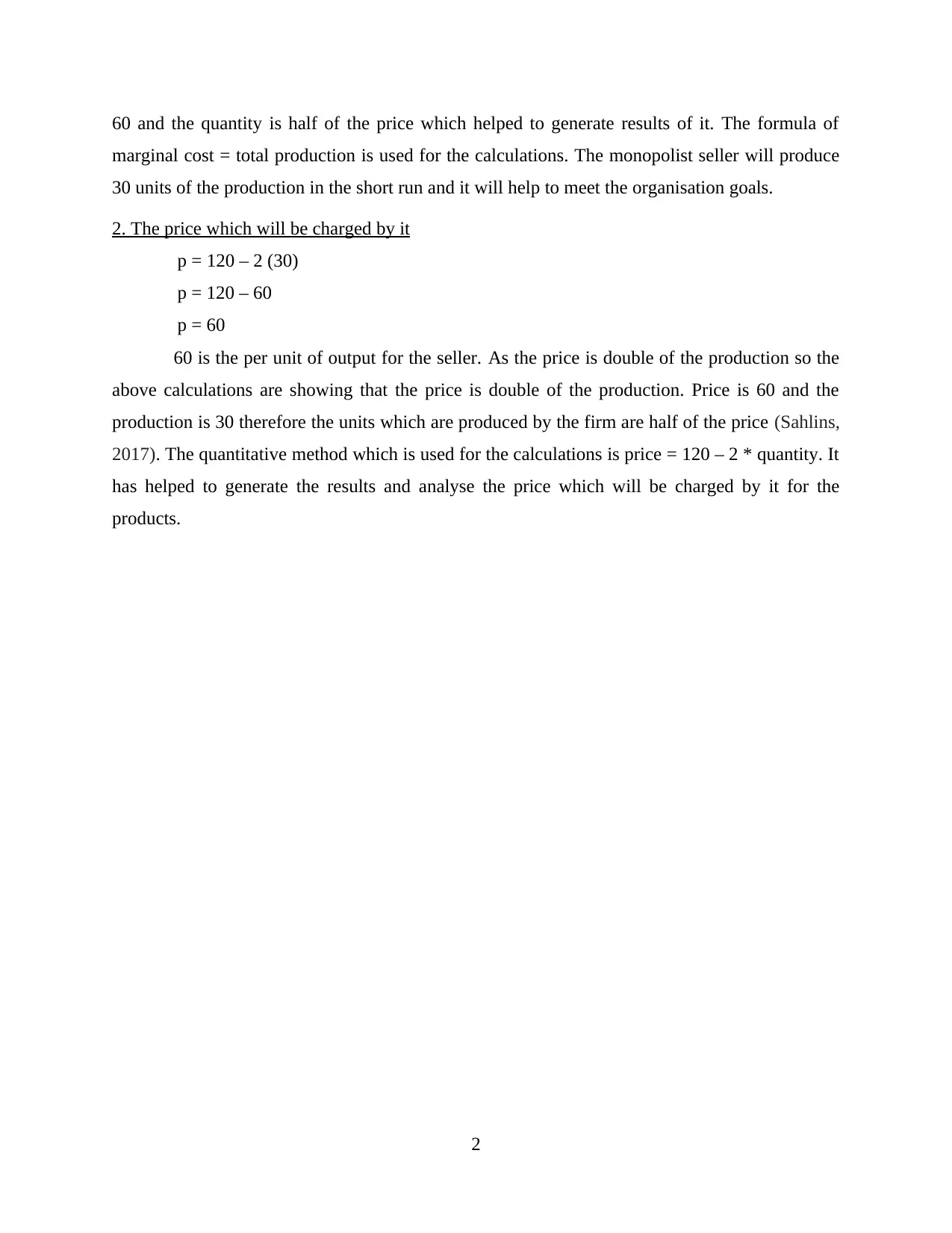
60 and the quantity is half of the price which helped to generate results of it. The formula of
marginal cost = total production is used for the calculations. The monopolist seller will produce
30 units of the production in the short run and it will help to meet the organisation goals.
2. The price which will be charged by it
p = 120 – 2 (30)
p = 120 – 60
p = 60
60 is the per unit of output for the seller. As the price is double of the production so the
above calculations are showing that the price is double of the production. Price is 60 and the
production is 30 therefore the units which are produced by the firm are half of the price (Sahlins,
2017). The quantitative method which is used for the calculations is price = 120 – 2 * quantity. It
has helped to generate the results and analyse the price which will be charged by it for the
products.
2
marginal cost = total production is used for the calculations. The monopolist seller will produce
30 units of the production in the short run and it will help to meet the organisation goals.
2. The price which will be charged by it
p = 120 – 2 (30)
p = 120 – 60
p = 60
60 is the per unit of output for the seller. As the price is double of the production so the
above calculations are showing that the price is double of the production. Price is 60 and the
production is 30 therefore the units which are produced by the firm are half of the price (Sahlins,
2017). The quantitative method which is used for the calculations is price = 120 – 2 * quantity. It
has helped to generate the results and analyse the price which will be charged by it for the
products.
2
Paraphrase This Document
Need a fresh take? Get an instant paraphrase of this document with our AI Paraphraser
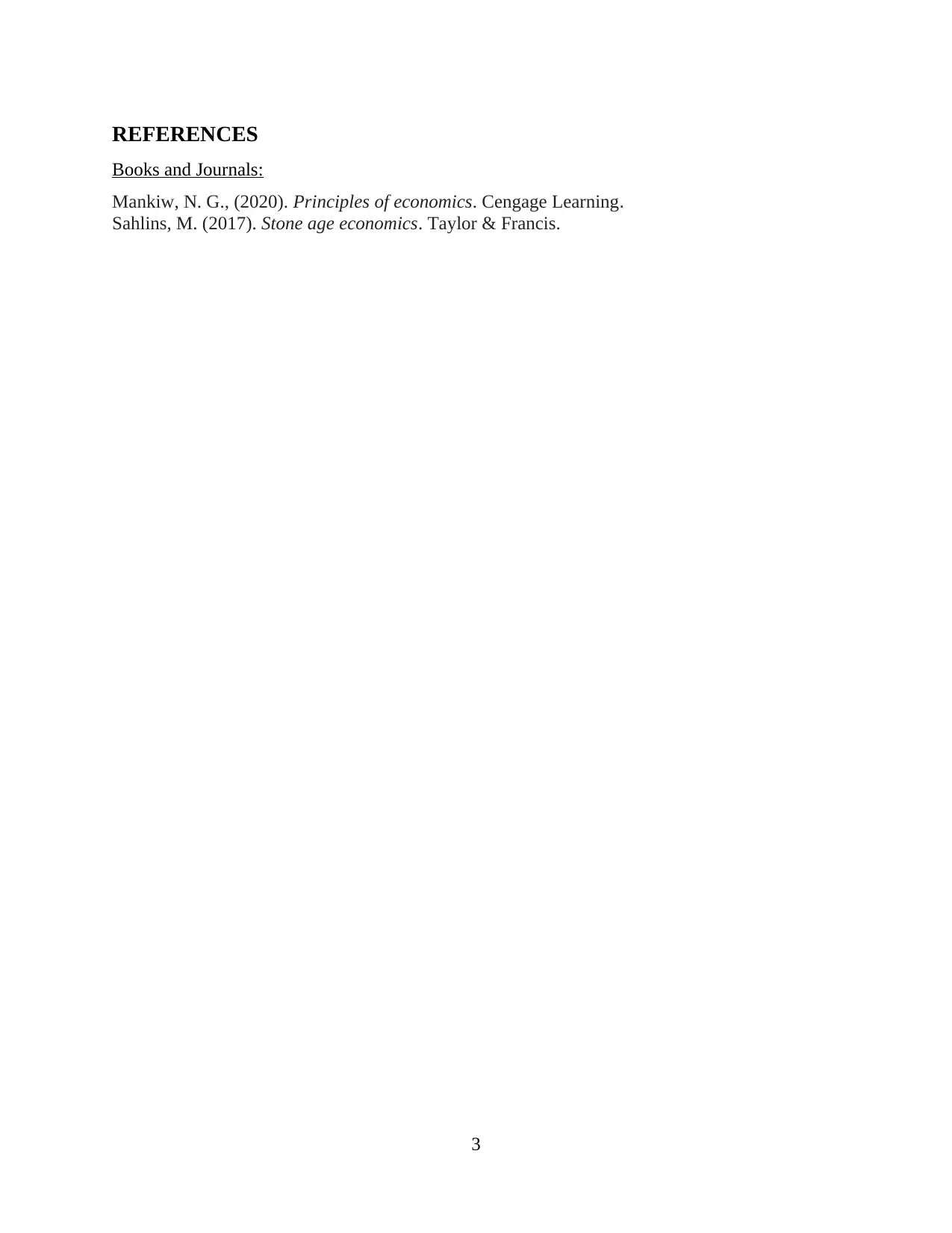
REFERENCES
Books and Journals:
Mankiw, N. G., (2020). Principles of economics. Cengage Learning.
Sahlins, M. (2017). Stone age economics. Taylor & Francis.
3
Books and Journals:
Mankiw, N. G., (2020). Principles of economics. Cengage Learning.
Sahlins, M. (2017). Stone age economics. Taylor & Francis.
3
1 out of 5
Related Documents
Your All-in-One AI-Powered Toolkit for Academic Success.
+13062052269
info@desklib.com
Available 24*7 on WhatsApp / Email
![[object Object]](/_next/static/media/star-bottom.7253800d.svg)
Unlock your academic potential
© 2024 | Zucol Services PVT LTD | All rights reserved.





